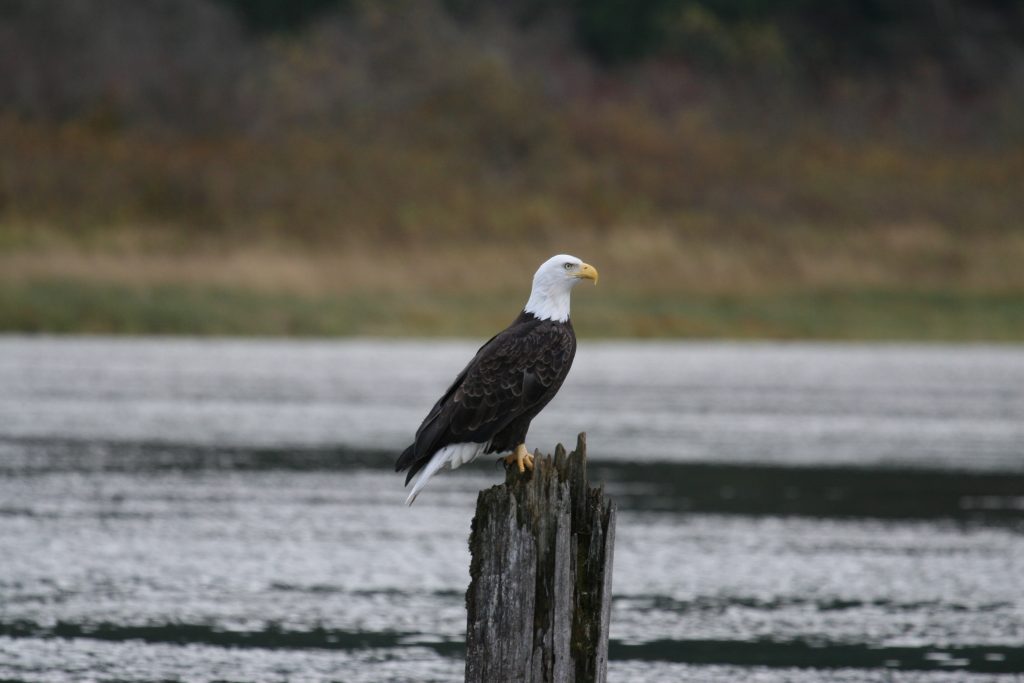British Columbia is home to many raptor species. Every Spring and Fall they migrate, providing an incredible experience for all levels of birders. During raptor migration, Spring is when they head to fresh ground farther North where their prey emerges from the cold Winter. In the Fall, raptors migrate back down South to follow the food.
Some raptors may stay in one area year-round. Temperate climates allow a raptor’s prey to breed all year long. Such areas like along BC’s coast, in the Lower Mainland, and on Vancouver Island, may see more year-round raptors.
In this blog, we’re going to explore raptor migration and what raptors you might see along the BC Bird Trail.

What Are Raptors
A raptor is a bird of prey that hunts and kills other animals. The word for raptor comes from the Latin word rapere, which means “to seize” or “to take by force.” Some familiar raptors to BC are eagles, hawks, owls, falcons, harriers, and vultures. Raptors have critical roles within BC’s ecosystems, specifically in regulating prey populations like small mammals, birds, and reptiles.
Birds of prey are known for having extremely good eyesight, similar to looking through a pair of binoculars. They use this keen eyesight to find food. Sharp talons, strong feet, and a strong curved beak are other common characteristics of raptors. While many raptor species hunt for food, a few of them are known to scavenge carrion, such as vultures.

Raptor Migration
Some raptor species travel great distances to go to and from different habitats. Some migrate to spend winter in a warmer location, while others migrate for breeding. In the summer months, many raptors migrate North to take advantage of the warmer weather and hunt for food. During the Fall, they migrate back down south to warmer climates where small animals are able to breed all year round, providing an excellent food source.
In colder parts of the province like the interior, raptors can be seen during migration but most won’t be stopping to spend the season. Instead, they will go further south until they hit warmer climates. Small numbers of raptors do stay, and you may see a Rough-legged hawk or a Northern-pygmy owl while out on the trails. The Kimberley Nature Park in Kimberley, on the Columbia Valley Bird Trail, is a great place to see raptors like Bald eagles and hawks.





Turkey Vulture Migration
Many spots in BC are stop-over grounds for birds and raptors during migration. Throughout September and October, thousands of turkey vultures can be seen kettling over Southern Vancouver Island. They are preparing to make their way to the subtropical and tropical wintering grounds in Southern California and Mexico.
A group of turkey vultures circling overhead is called a kettle. They use hot air thermals from the ground to rise high up into the air and move from place to place. This means they don’t have to use huge levels of energy to travel long distances. Spots along the Langford Bird Trail Outpost are a good place to watch for large groups of kettling turkey vultures. You can also spot these annual turkey vulture kettles over Victoria and Sooke on Vancouver Island.

Bald Eagle Migration
Another notable raptor migration is when the bald eagles begin to arrive in the Fall. Thousands of Bald Eagles migrate down from their Northern summer grounds in Alaska, Yukon and Northern BC to warmer winter habitats further south. The bald eagles show up to perfectly match up with the salmon spawning season. The increase in salmon attracts a frenzy of bald eagles looking for a feast. Bald eagles can be seen all over the province from November to January, depending on where you go.
The Harrison River Valley on the Fraser Valley Bird Trail is known for its winter gathering of bald eagles. Goldstream Park on the Langford Bird Trail Outpost has a gathering of bald eagles following the salmon spawn. The winter bald eagle congregation in Squamish along the Squamish River Valley is one of the most significant areas of wintering bald eagles in North America. Check out the eagle viewing tours available in Brackendale. You can also make your way to the Eagle Run Viewing Shelter (located on the dyke across from Brackendale Eagles Provincial Park) and watch for eagles.

Hawk Migration
Similar to bald eagles, hawks spend the summer up north and migrate back down south into BC through the Winter. Hawks benefit from the good visibility on open plains and fields since all the summer foliage is gone. In warmer climates in BC, such as the Lower Mainland and along the Coast, large numbers of raptors will stay for the whole season. The small rodents that breed throughout the winter entice the raptors to stay longer.
Travelling along the trail from Terra Nova Park in Richmond, down to Garry Point Park takes you along a perfect stretch for hawk viewing. Specifically, the Sturgeon Banks habitat is excellent for raptors such as Cooper’s Hawks, Red-tailed hawks, Northern Harriers, Merlins, and Bald eagles.

We hope all this raptor migration information can help you spot some raptors on your next birding adventure! Be sure to head out during peak times of the year for the best viewing opportunities. If you’re lucky you may even spot the elusive Northern harrier, which is considered a nice treat that isn’t as common as hawks like Cooper’s or Red-tailed.
For more raptor migration information, check out this in-depth PDF for BC Guidelines for Raptor Conservation. You can also head to the British Columbia Breeding Bird Atlas.



